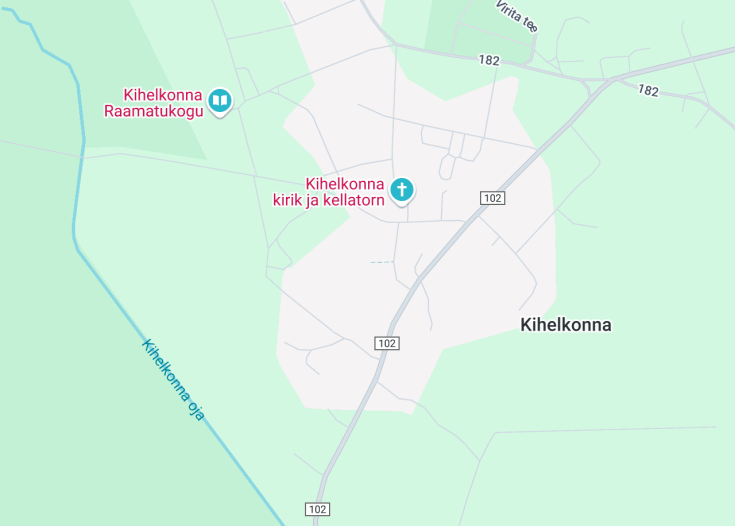Nestled in the tranquil village of Kihelkonna, Estonia, the Kihelkonna Kiriku Kellakoda stands as a remarkable testament to the region’s rich cultural heritage and architectural elegance. This bell tower, adjacent to the historic Kihelkonna Church, offers visitors a unique glimpse into the local traditions and the significance of bells in Estonian society.
For travelers eager to explore the Kihelkonna Kiriku Kellakoda, it’s advisable to visit during local festivities when the bells ring, creating a vibrant atmosphere that enhances the experience of this unique landmark.
Consider timing your visit in early summer, as the surrounding landscape is adorned with blooming wildflowers, providing a stunning backdrop for your exploration of the bell tower and the adjacent church.
Kihelkonna Kiriku Kellakoda: Echoes of History in Estonia
Nestled in the heart of Kihelkonna, Estonia, the Kihelkonna Kiriku Kellakoda stands as a testament to the region’s rich cultural and historical heritage. This charming bell house, adjacent to the historic Kihelkonna Church, offers visitors a unique glimpse into traditional Estonian architecture and community life. The Kellakoda has been meticulously preserved, allowing tourists to appreciate the intricate craftsmanship and the pivotal role it played in the town’s spiritual and social activities. From its sturdy wooden structure to the resonant bells that once called the community to gatherings, every element of the Kellakoda tells a story. Visitors can explore the interior, which houses historical artifacts and exhibits detailing the bell house’s significance over the centuries. Surrounded by picturesque landscapes, the Kihelkonna Kiriku Kellakoda is not only a beacon for history enthusiasts but also a serene spot for those seeking to immerse themselves in the tranquil beauty of rural Estonia.
Exploring the Architectural Marvels of Kihelkonna’s Bell House
The Kihelkonna Kiriku Kellakoda offers a captivating journey through Estonia’s architectural history. Visitors can admire the traditional wooden construction, showcasing expert joinery and timeless design elements that have withstood the test of time.
Interactive Exhibits
Inside, interactive displays provide insights into the craftsmanship involved in bell making and maintenance, offering a hands-on experience for all ages.
Guided Tours
Knowledgeable guides lead tours that delve into the bell house’s historical significance, sharing fascinating anecdotes and lesser-known facts that bring the site to life.
Cultural Events
Throughout the year, the Kihelkonna Bell House hosts cultural events, including traditional music performances and community gatherings, allowing visitors to engage with local customs and traditions. Whether you’re an architecture buff, a history lover, or simply seeking a peaceful retreat, exploring the architectural marvels of Kihelkonna’s bell house is a must-do activity that enriches your understanding of Estonia’s vibrant heritage.
Discover the Resonant Bells: A Soundtrack to Kihelkonna’s Heritage
An intriguing aspect of the Kihelkonna Kiriku Kellakoda is its collection of historic bells, each with its own unique story. These bells were traditionally used to signal the time for prayers, mark significant events, and call the community together during times of celebration or need. The rich, sonorous tones of the bells not only served practical purposes but also became a beloved symbol of Kihelkonna’s enduring spirit. Today, visitors have the opportunity to listen to recordings of these bells, allowing them to connect with the sounds that have echoed through the town for generations. Additionally, informative displays detail the craftsmanship behind each bell, highlighting the artistry and skill required to create these enduring instruments. This auditory glimpse into the past adds a profound layer to the cultural experience, making the Kihelkonna Kiriku Kellakoda a truly immersive destination for those eager to explore Estonia’s sonic heritage.
Discover the Charm of Kihelkonna Kiriku Kellakoda in Kihelkonna, Estonia
Experience the rich historical ambiance of Kihelkonna Kiriku Kellakoda, a must-visit landmark nestled in the heart of Kihelkonna. Ideal for history enthusiasts, architecture lovers, and cultural explorers, this exquisite church facility offers a serene environment where visitors can immerse themselves in Estonia’s spiritual and architectural heritage. As part of a broader Saaremaa tourist itinerary, a visit to Kihelkonna Kiriku Kellakoda seamlessly complements tours of nearby castles, museums, and picturesque landscapes. Professional guides recommend arriving early to enjoy the tranquil surroundings and to capture stunning photographs of the structure’s intricate details. A unique tip is to attend a local service or bell-ringing session, providing an authentic glimpse into the community’s traditions.
When to Visit Kihelkonna Kiriku Kellakoda
The best time to explore Kihelkonna Kiriku Kellakoda is during the late spring and early autumn months. During these seasons, the weather is pleasant, and the surrounding landscapes are vibrant with blooming flowers or autumnal hues, enhancing the overall visitor experience.
Seasonal Events
Consider planning your visit around the annual Kihelkonna Church Festival, typically held in June. This event features traditional music, guided tours, and special ceremonies, offering a deeper understanding of the local culture.
Accessibility and Limitations
While Kihelkonna Kiriku Kellakoda welcomes visitors from all walks of life, there are certain limitations to be aware of.
Accessibility
Limitations
- Photography is restricted during services.
- Large groups may require prior booking.
- Access to certain areas is limited outside of visiting hours.
Notes to Visitors
- Respect the sanctity of the space by maintaining silence during your visit.
- Wear appropriate attire when entering the church area.
- Check the schedule for any special events that may affect opening times.
General Informations
Plan your visit to Kihelkonna Kiriku Kellakoda with ease by familiarizing yourself with essential details and tips to make the most of your experience.
Location
Located conveniently near the bustling town center, Kihelkonna Kiriku Kellakoda is easily accessible from major landmarks such as the Kihelkonna Town Hall and the Saaremaa Museum. Public transport options make it a breeze to include in your sightseeing itinerary.
Address: Kiriku 1 – Kihelkonna, 79312
Visiting Information
Kihelkonna Kiriku Kellakoda welcomes visitors throughout the year. While there are no strict closing times, the best time to visit is in the morning when the light illuminates the architectural beauty of the building. Early visits also allow you to enjoy a more peaceful experience before the day’s activities begin.
How to Reach Kihelkonna Kiriku Kellakoda
Traveling to Kihelkonna Kiriku Kellakoda is straightforward, whether you prefer driving or using public transportation.
Car
Kihelkonna Kiriku Kellakoda can be easily reached by car. Parking is available on-site with ample space for visitors. Additionally, several nearby parking lots offer convenient options for a small fee.
| Route | Distance | Travel time |
|---|---|---|
| From Kuressaare | 35 miles (56 km) | 45 minutes |
| From Tallinn | 95 miles (153 km) | 2 hours |
| From Tartu | 120 miles (193 km) | 2 hours 30 minutes |
Bus
Regular bus services connect Kihelkonna Kiriku Kellakoda with Saaremaa’s main transportation hubs. Buses are a reliable and eco-friendly option, with travel times varying based on departure points.
| Route | Distance | Travel time |
|---|---|---|
| From Kuressaare | 35 miles (56 km) | 1 hour |
| From Tallinn | 95 miles (153 km) | 3 hours |
| From Pärnu | 80 miles (128 km) | 2 hours 15 minutes |
Nearby Attractions
- Saaremaa Museum – 2 miles (3.2 km)
- Kuressaare Castle – 15 miles (24 km)
- Kaali Meteorite Crater – 20 miles (32 km)
- Tehumardi Memorial – 25 miles (40 km)
- Sõrve Peninsula – 30 miles (48 km)
- Espoon Lahemaa National Park – 10 miles (16 km)
- Vilsandi National Park – 40 miles (64 km)
- Angla Windmill Park – 5 miles (8 km)
- Virtsi Windmill – 4 miles (6.4 km)
- Rannapungerja Harbor – 18 miles (29 km)
- Pääsküla Beach – 12 miles (19 km)
- Kuremüe Folk Art Museum – 22 miles (35 km)
Common questions
What is the historical significance of Kihelkonna Kiriku Kellakoda?
What architectural features distinguish Kihelkonna Kiriku Kellakoda?
- Steep Roof: Designed to prevent snow accumulation, the steeply pitched roof is both functional and aesthetically pleasing.
- Wooden Construction: Crafted primarily from local timber, the Kellakoda exhibits masterful woodworking techniques.
- Decorative Carvings: Intricate carvings adorn the façade, depicting religious symbols and local motifs.
- Bell Chambers: The structure houses multiple chambers for different bells, each with its unique acoustical properties.
These features not only enhance the building’s visual appeal but also demonstrate the craftsmanship and architectural ingenuity of the era in which it was built.
Are there guided tours available at Kihelkonna Kiriku Kellakoda?
- Historical Overview: Learn about the Kellakoda’s origins, its role in the community, and significant events it has witnessed.
- Architectural Insights: Detailed explanations of the building’s design, materials used, and unique architectural features.
- Bell Mechanics: An exploration of how the bells operate, including live demonstrations if available.
- Cultural Significance: Understanding the Kellakoda’s place in local traditions and its impact on Kihelkonna’s cultural landscape.
Tours are typically conducted in [languages available], and it’s advisable to book in advance, especially during peak tourist seasons.
What is the history of the church bells at Kihelkonna Kiriku Kellakoda?
Can visitors ring the bells at Kihelkonna Kiriku Kellakoda?
What events take place at Kihelkonna Kiriku Kellakoda?
- Concerts: Featuring local choirs and orchestras that utilize the acoustics of the bell house.
- Festivals: Celebrations during traditional Estonian holidays often incorporate the sounds of the church bells.
- Historical Reenactments: Events that depict significant moments from the Kellakoda’s history.
- Exhibitions: Showcasing artifacts, photographs, and documents related to the Kellakoda and Kihelkonna’s heritage.
These events not only enhance the cultural vibrancy of Kihelkonna but also provide visitors with immersive experiences that highlight the Kellakoda’s significance.
Is photography allowed inside Kihelkonna Kiriku Kellakoda?
- No Flash Photography: To protect the interior elements and artifacts, flash photography may be restricted.
- No Tripods: The use of tripods is often prohibited to maintain clear pathways and ensure visitor safety.
- Restricted Areas: Certain sections, especially those housing delicate artifacts or operational bell mechanisms, may be off-limits to photography.
It’s advisable to confirm the current photography policies upon arrival or with tour guides to ensure compliance with the Kellakoda’s regulations.
What restoration efforts have been made for Kihelkonna Kiriku Kellakoda?
- Structural Reinforcement: Addressing wear and tear in the wooden framework to prevent decay and collapse.
- Bell Maintenance: Regular tuning and repairs of the bells to preserve their sound quality.
- Aesthetic Restoration: Replicating original carvings and decorative elements to restore the building’s historical appearance.
- Environmental Protection: Implementing measures to protect the Kellakoda from moisture, pests, and other environmental factors.
These efforts are often supported by local government funds, grants, and community involvement, ensuring that Kihelkonna Kiriku Kellakoda remains a cherished landmark for future generations.
How does Kihelkonna Kiriku Kellakoda contribute to local culture?
- Religious Significance: As the bell house for the church, it plays a pivotal role in religious ceremonies and daily services.
- Community Gathering Spot: The Kellakoda is often a focal point for community events, fostering social cohesion.
- Cultural Heritage: It embodies the architectural and historical legacy of Kihelkonna, serving as a tangible link to the past.
- Tourism Attraction: Drawing visitors to the area, it promotes cultural exchange and supports the local economy.
Through these contributions, Kihelkonna Kiriku Kellakoda not only preserves the heritage of the town but also actively enriches the cultural life of its inhabitants.
What materials were used in the construction of Kihelkonna Kiriku Kellakoda?
- Timber: High-quality wooden beams and planks were used for the structural framework, exploiting the rich forests of Saaremaa.
- Stone: Local stone was employed for foundational elements and decorative accents, providing durability and aesthetic appeal.
- Metal: Iron fixtures and fittings were incorporated for functionality and ornamentation, particularly in the bell mechanisms.
- Glass: Stained glass windows adorn the Kellakoda, adding both beauty and protection from the elements.
The combination of these materials not only ensured the building’s resilience but also allowed for intricate decorative work, making Kihelkonna Kiriku Kellakoda a beautiful example of traditional Estonian craftsmanship.
Are there any legends or stories associated with Kihelkonna Kiriku Kellakoda?
How does the design of Kihelkonna Kiriku Kellakoda reflect the era it was built in?
- Medieval Influences: Elements such as pointed arches and ribbed vaults hint at Gothic architectural influences common in medieval ecclesiastical buildings.
- Functional Design: The layout emphasizes functionality, with dedicated spaces for bell storage, maintenance, and operation, showcasing an era when craftsmanship was tailored to specific needs.
- Local Materials: The use of indigenous timber and stone aligns with the sustainable building practices of the period.
- Ornamental Details: Carvings and decorative motifs reflect the artistic trends of the time, incorporating both religious symbolism and local cultural elements.
Together, these design features provide insight into the architectural trends and societal priorities of the time when Kihelkonna Kiriku Kellakoda was constructed.
What role does Kihelkonna Kiriku Kellakoda play in modern Kihelkonna?
- Cultural Hub: Hosting events such as concerts, exhibitions, and festivals that celebrate local traditions and arts.
- Historical Landmark: Acting as a point of interest for tourists and a source of pride for residents, highlighting the town’s heritage.
- Community Services: Occasionally used for gatherings, meetings, and other community-oriented functions.
- Educational Resource: Providing opportunities for local schools and organizations to learn about architecture, history, and music through guided tours and interactive programs.
By fulfilling these roles, Kihelkonna Kiriku Kellakoda remains a dynamic and integral part of modern Kihelkonna, bridging the past with the present.
How can one learn more about the history of Kihelkonna Kiriku Kellakoda?
- Local Archives: The Kihelkonna municipal archives house historical documents, photographs, and records related to the Kellakoda.
- Guided Tours: Participating in guided tours offered at the Kellakoda provides firsthand insights from knowledgeable guides.
- Local Libraries: Libraries in Kihelkonna and the broader Saare County region offer books and publications on the area’s history and architecture.
- Historical Societies: Engaging with local historical societies can provide access to specialized research and events focused on the Kellakoda’s heritage.
- Online Resources: Official websites and digital archives may feature detailed histories, virtual tours, and multimedia presentations.
By utilizing these resources, enthusiasts and researchers can gain a comprehensive understanding of the Kihelkonna Kiriku Kellakoda’s significance and legacy.

Is Kihelkonna Kiriku Kellakoda in Kihelkonna, Estonia Worth Visiting?
The Kihelkonna Kiriku Kellakoda in Kihelkonna, Estonia, offers visitors a unique glimpse into the region’s cultural and architectural history. The building’s traditional design and intricate details showcase the craftsmanship of the era, making it a fascinating stop for history enthusiasts. Additionally, the location provides a peaceful atmosphere, perfect for those looking to explore beyond the typical tourist trails. However, accessibility might be a concern for some, as it’s situated in a more remote area. Nonetheless, its authentic charm and historical significance make the Kihelkonna Kiriku Kellakoda a worthwhile destination for anyone interested in exploring Estonia’s rich heritage.









